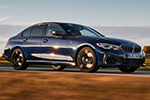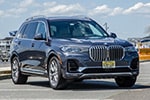According to Frank Weber, a BMW Board Member responsible for Development, the inaugural all-electric BMW M3 is scheduled for release in 2027. This M3 EV will be constructed using the Neue Klasse architecture, with the codename ZA0 (revealed exclusively by us). While numerous reports have emerged today, it’s important to note that most, if not all of them, are highly speculative regarding the vehicle’s power output.
Rumored Around 700 Horsepower
 Screenshot from BMW Presentation Video
Screenshot from BMW Presentation VideoThis isn’t the first time Weber has mentioned a power limit of 1 Megawatt, which roughly translates to around 1,340 horsepower. However, it’s crucial to understand that this figure represents the upper limit of the new architecture and won’t necessarily result in an M3 boasting over 1,000 horsepower, at least not in the initial release. Our own sources mention a potential power output around the 700 horsepower mark. Of course, we expect BMW M to offer several variants of the M3 and M4 electric models with different power outputs. But no where near the 1,340 hp.
Built on Neue Klasse
 Screenshot from BMW Presentation Video
Screenshot from BMW Presentation VideoThe ZA0 BMW M3 is based on the Neue Klasse BMW i3 (NA0) which will launch in 2026, a year after the BMW iX3 (NA5). The M3 EV will send the power to all four wheels and will make use of BMW’s Heart of Joy. During a conversation with Frank Weber, BMW Board Member and Development, we learned more about this innovative system which promises to redefine the driving experience in all future BMW electric vehicles. The “Heart of Joy” marks a significant milestone for BMW, as it combines powertrain software and driving dynamics into a single, unified system.
By consolidating all elements into a unified software stack, BMW’s centralized system exhibits significantly less latency compared to traditional architectures. This efficiency stems from the fact that all sensors and functions operate within the same software stack. As an illustrative example, BMW contrasted this with the use of different Electronic Control Units (ECUs) on a bus system, where delays of up to 10 to 20 milliseconds can occur. However, with the “Heart of Joy,” this latency can be reduced to as little as 1 millisecond.
According to BMW’s Head of Research and Development, having a system that operates ten times faster offers substantial advantages, particularly in terms of overall performance and driving dynamics. These benefits can be realized whether you’re on a racetrack or navigating through winding and challenging backroads. BMW M seems to be determine to go all-in with their electrification plans, same as they would with the BMW iX3M, codename ZA5, which will arrive in 2026.





































































